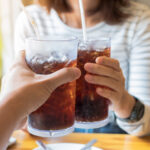by: December 5, 2024
 (NaturalHealth365) It’s estimated that one in four adults suffers from nonalcoholic fatty liver disease (NAFLD), a condition where excess fat accumulates in the liver without alcohol being a factor. While alcohol is a well-known culprit of liver disease, a recent study published in the Annals of Hepatology highlights another surprising contributor: soft drinks.
(NaturalHealth365) It’s estimated that one in four adults suffers from nonalcoholic fatty liver disease (NAFLD), a condition where excess fat accumulates in the liver without alcohol being a factor. While alcohol is a well-known culprit of liver disease, a recent study published in the Annals of Hepatology highlights another surprising contributor: soft drinks.
The research reveals a strong link between increased soft drink consumption and a higher risk of developing NAFLD, raising concerns about the impact of sugary beverages on liver health.
The alarming link between soda consumption and liver disease: What the latest study reveals
If you’re someone who can’t resist soda, you’re not alone – soft drinks, sugary sports beverages, and other sugar-filled bottled drinks are highly addictive. However, the latest study published in the Annals of Hepatology raises serious concerns: drinking more soft drinks is linked to a significantly higher risk of developing nonalcoholic fatty liver disease. The data also highlights that men are more likely to develop liver disease from increased soda consumption than women.
The initial data collection occurred between 2004 and 2006, and only participants aged 20 or older were included. A follow-up analysis conducted from 2010 to 2012 added 186 new individuals, with 1,627 participants remaining in the study.
Diet sodas or those with zero calories were excluded from the analysis.
- 28% of men consumed between one and three and a half servings of soft drinks per week.
- 47.4% of men consumed more than three and a half servings per week.
- 31.1% of women consumed between one and three and a half servings of soft drinks per week.
- 26.5% of women consumed more than three and a half servings per week.
The median weekly soft drink intake for participants was 3.1 servings.
Why NAFLD risk varies between men and women: A key insight from the study
The study reveals a significant increase in the risk of NAFLD with higher soft drink consumption, showing a 39% higher likelihood of developing NAFLD when soft drink intake rises from less than one serving per week to more than three and a half servings per week.
One of the most striking findings is that men have a higher risk of NAFLD as their soft drink consumption increases compared to women. While both sexes see a rise in risk with greater soft drink intake, the increase is more pronounced in men. This suggests that metabolic differences between men and women may play a key role in how the body responds to soft drink consumption, contributing to the observed variances in NAFLD risk.
Simple and natural strategies to kick your soda habit
Kicking your soda habit might sound tough, but it’s more doable than you think! Instead of going cold turkey, try weaning yourself off the sugary drinks gradually. A gentle transition can make the process feel less overwhelming.
Start by swapping out your soda for sparkling water. The fizz can help satisfy that craving for something bubbly, and you can add a splash of lemon, lime, or cucumber to give it a refreshing twist. If you’re missing the sweetness, flavored waters with natural extracts like mint or berry are a great option, too.
Try kombucha if you’re looking for something with a little more punch. This tangy, fermented tea is naturally fizzy and can help curb those cravings while also boosting your gut. Another tasty option is prebiotic sodas – these offer the fizz and a bit of sweetness without the sugar overload.
For a more festive alternative, sparkling non-alcoholic champagne or grape juice can be a fun treat that feels like a special occasion, minus the sugar high. And if you’re craving something warm, herbal teas can be a comforting choice. You can naturally sweeten them with some honey or stevia if needed.
By gradually replacing soda with these simple, flavorful alternatives, you’ll take steps toward a healthier lifestyle without feeling like you’re missing out!
Sources for this article include:
No hay comentarios:
Publicar un comentario